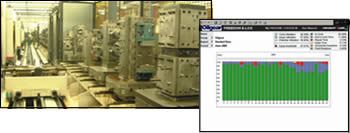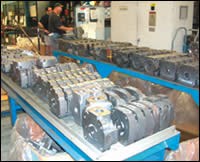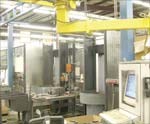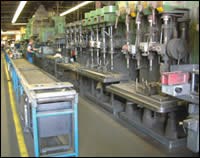The In-Cycle Enabler
To achieve 144 hours per week of in-cycle time on its machining centers, this plant relies on software that offers a clear, colorful, real-time view of where the time losses are occurring.
Share




At the manufacturing facility for the Oilgear Company in Fremont, Nebraska, plant manager Tony Goff is frank in describing the plant’s long lines of manually operated drilling machines. “These lines are 1960s technology,” he says.
However, that technology is more productive now than ever before, and the reason has nothing to do with any attention the drilling machines have received. The reason has to do with modernization occurring elsewhere in the plant. Today, a flexible cell with five horizontal machining centers linked by an automated pallet system shares the workload with the older lines. The key to getting the most value out of this cell has been a software utility that lets decision-makers throughout the plant react to the cell’s performance in real time. Because the software makes the flexible cell even more effective for small- and medium-size runs, the older lines can remain set up for the simpler and higher-volume parts that they do best—meaning the hours once spent on change-over can now be devoted to pure production. As a result, the software for managing a flexible cell has found new capacity on even the manual machines.
Strong All Week
The “Cincron” flexible cell and its associated software come from Cincinnati Lamb (Hebron, Kentucky). The software, “Freedom E-Log,” has been critical to both the success of this cell and the continued success of the Fremont plant.
The software marshals the information pouring out of any collection of CNC machines. That information can include maintenance alarms, spindle loads, cycle times, tool lives, operator reports and more. By formatting all of the data into easily understandable graphical displays that are tailored to the different needs of different users, the software unlocks a variety of practical uses for the data. Achieving greater productive time is perhaps the most significant of these uses. By allowing users to quickly comprehend the needs of the machines, it empowers them to quickly address those needs as well.
The quick response is essential. For the Fremont plant to remain cost-effective to the Oilgear Company (headquartered in Milwaukee, Wisconsin), this plant had to be able to produce both around the clock and throughout the week.
The “throughout the week” part of that requirement is different. Most plants that run around the clock don’t do this. Instead of 24/7, they run 24/5. Running 24/7 is an altogether different challenge, says Mr. Goff, because there is no cushion in the form of weekend overtime with which to recover from delays. At 24/7, lost time is lost forever, so the pressure falls to plant personnel to ensure that all productivity losses are kept tightly controlled. Their success at doing this can be measured in the in-cycle time for the five machining centers, a measure that currently averages 85.7 percent. This “in-cycle” figure takes account of all non-productive time, including even repairs and shut-downs for planned holidays. (See the illustration above.) The percentage means that out of 168 hours in a week, this plant routinely captures 144 for producing parts.
From Viewing To Doing
The plant makes axial piston pumps for large vehicles such as trucks and excavators. It ships 30,000 pumps per year, in various designs, often in lot sizes of one or two. Average order quantity is less than four. The Cincron cell, with its 41 pallets, handles about 300 different part numbers.
This cell began with just two machines. Back then, production managers used spreadsheets to track the cell’s output—primarily just to confirm that the aggressive targets for these machines were being met. Later, when the plant assisted Cincinnati Lamb in the development of the Freedom E-Log software, the plant’s hope for this software was simply that it would make the tracking more automatic. Once viewing the data became easy, however, acting on the data was just a short leap away.
The software organizes machine-tool events into bar charts or pie charts that are viewable throughout the plant’s network. Clicking on any element of a chart reveals specific detail about the events that produced that particular element, and clicking on one of those events can reveal still more detail. The software’s intuitive structure thus makes it easy for users to mine down to whatever level of specificity they need. Not just limited to flexible cells, the software can also serve collections of machines that are not linked in this way. It can even be used with collections of machine tools that come from various builders.
The software addresses different needs in different time windows. Sid Ellis, manufacturing and maintenance manager for the Fremont plant, typically looks at a daily view. A color-coded display of the past 24 hours of performance shows him any problems that may need attention at once. If he sees a maintenance alarm, he may check with the maintenance technician to determine how the problem will be addressed. If there is a problem that relates to a particular tool, he may have a similar conversation with a member of the manufacturing engineering group.
Mr. Goff is more likely to look at a yearly view. As plant manager, he develops projections and justifies investments, so the longer-term perspective is useful.
Meanwhile, on the production floor, operators see production events as they occur, and they provide the input that is vital to help others in the organization make sense of the information. An “operator comments” function allows operators to attach explanatory notes to any data item. As straightforward as the capability may sound, Mr. Ellis and Mr. Goff both agree that this feature has been particularly significant for the plant. Using this feature, the operators—who are on the front lines of the plant’s production—can easily convey to the plant and the company what challenges they are facing and how they are addressing them. They can also communicate easily between shifts, meaning that a member of the weekend crew now has access to as much current production-related intelligence as any weekday employee.
Not all events demand operator comments. In fact, most events do not, because the software also allows the plant to compose its own codes for regular events that don’t require explanation. When Mr. Ellis is not looking at a daily view, he is looking at a view that spans many days or many weeks, in search of trends or patterns in regular events such as these.
Others in the organization look at the data in this same way. They ask, for example: Does a particular tool break repeatedly or wear out too quickly? Should a certain maintenance item be performed more often? Do patterns in spindle performance suggest when a spindle should be replaced? Does a particular part number consistently fail to meet its cycle time goal, and if so, why? While the daily view shows the problems that are current or emerging, the longer view can be used to anticipate the problems that might be avoided before they ever become costly.
Allocating Work
The plant will add more machining centers, Mr. Goff says. He is confident of this, because the 87.5 percent in-cycle time makes additional machines well worth the price. For now, however, plant personnel apply the capacity of the five existing machining centers thoughtfully, looking to maximize both the value of this capacity and the value of the capacity of the drilling lines.
It is not just volume that determines which jobs go where, says Mr. Ellis. Relative backlog is also a consideration, with many part numbers routinely being run on either type of machine, depending on where capacity is available at that moment.
Scrap rate is an indicator, too. The non-CNC lines do not benefit from the software’s ability to reveal subtle trends, but scrap rates provide a measure of less subtle feedback that the plant watches closely. Does a particular part show a scrap rate that is unusually high? If so, perhaps that part’s complexity makes the part difficult to error-proof on manual equipment. When this is the case, the complexity may offer yet another reason—entirely unrelated to volume—for why the part should be sent to the CNC cell.
Related Content
6 Machine Shop Essentials to Stay Competitive
If you want to streamline production and be competitive in the industry, you will need far more than a standard three-axis CNC mill or two-axis CNC lathe and a few measuring tools.
Read MoreHow to Mitigate Chatter to Boost Machining Rates
There are usually better solutions to chatter than just reducing the feed rate. Through vibration analysis, the chatter problem can be solved, enabling much higher metal removal rates, better quality and longer tool life.
Read MoreInside a CNC-Machined Gothic Monastery in Wyoming
An inside look into the Carmelite Monks of Wyoming, who are combining centuries-old Gothic architectural principles with modern CNC machining to build a monastery in the mountains of Wyoming.
Read MoreWhich Approach to Automation Fits Your CNC Machine Tool?
Choosing the right automation to pair with a CNC machine tool cell means weighing various factors, as this fabrication business has learned well.
Read MoreRead Next
Registration Now Open for the Precision Machining Technology Show (PMTS) 2025
The precision machining industry’s premier event returns to Cleveland, OH, April 1-3.
Read MoreBuilding Out a Foundation for Student Machinists
Autodesk and Haas have teamed up to produce an introductory course for students that covers the basics of CAD, CAM and CNC while providing them with a portfolio part.
Read MoreSetting Up the Building Blocks for a Digital Factory
Woodward Inc. spent over a year developing an API to connect machines to its digital factory. Caron Engineering’s MiConnect has cut most of this process while also granting the shop greater access to machine information.
Read More





































